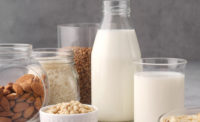U.S. sales of plant-based milks reached $2.8 billion in 2022, according to the Plant-Based Foods Association. “Plant-based milk remains the largest segment in the plant-based foods industry, with 40.6% of U.S. households purchasing plant-based milks, and an astounding 75.7% of consumers repeating their purchases,” the organization stated.
The next largest category is plant-based creamers, with sales of $645 million in 2022, and an annual growth rate of 24%. Other categories in order of size are plant-based ice cream ($437 million), yogurt ($425 million), protein liquids and powders ($341 million), butter ($311 million), and cheese ($233 million).
Although plant-based cheese and ice cream both showed declines in total sales last year, all other dairy alternatives saw positive growth trajectories.
Sales of plant-based dairy alternatives are driven by the perception that they are healthier for individuals and healthier for the planet. But how does the nutrition actually compare to real dairy?
Show me the nutrition
I surveyed real and alternative dairy products sold at my local Whole Foods. In the cheese category, there are a wide variety of product types, including alternatives for mozzarella, ricotta, Cheddar, provolone, Colby, cream, and Mexican blends. They were available in blocks, slices and shreds.
Most alternative cheese is made with water, coconut oil and food starches. As might be expected, they are thus higher in saturated fat and carbohydrates, and lower in protein than real dairy cheese.
The coconut oil-based cheeses that I examined all had zero grams of protein. Yet, the alternative cheeses made with nuts had better nutrition profiles. Cashew-based cheeses had even lower saturated fat than dairy cheese, and around 3 grams of protein per ounce, compared to 3 to 8 grams per ounce for real dairy cheese.
In the yogurt category, nutrition was a little better, but the amount of protein still lagged behind traditional dairy. Not surprisingly, there is very little Greek plant-based yogurt. Exceptions were Kite Hill Greek-Style plant based yogurt with 17 grams of plant protein from almond and soy protein isolate, and Silk Greek-style yogurt with 10 grams of protein from pea protein.
Most people eat ice cream and frozen dessert for indulgence, rather than for nutrition. As such, there was a wide range of nutrition values, with plant-based frozen desserts containing 1 or 2 grams of protein, versus 4 to 6 grams for dairy ice cream. Generally, plant-based frozen desserts were relatively high in calories, fat, and added sugars. However, the Oatly brand of frozen desserts weighed in at just 210 calories per serving, lower than most of the nut-based options.
Alternative cheese innovations
Plant-based cheese is the most challenging category for sensory attributes and I found that out firsthand as I sampled a variety of plant-based cheese. Some compared favorably in taste, texture, and functionality to real dairy, but many fell short, especially on the all-important taste scale.
Plant proteins often result in off-color, beany or astringent flavors and grainy texture to cheese alternatives. Novel protein sources, fermentation technologies, breeding technologies, and even artificial intelligence, are strategies that might improve the nutritional and sensory properties of next-generation, plant-based cheese alternatives.
One strategy to improve protein quality is to combine and use a variety of plant protein sources. Nuts for Cheese produces an “Un-Brie-Lievable” organic fermented cashew product. This spreadable brie alternative is made with cashews, quinoa, rice, and chickpeas. One ounce delivers 3 grams of protein.
ChickP has developed a chickpea protein isolate that could deliver improved nutrition and sensory properties in cheese alternatives. Their cream cheese formulation has a tangy cheese-like flavor obtained from fermentation with lactic bacteria, just like the traditional milk-based process, reports Nevo Mazor, marketing manager for ChickP Protein Ltd.
As a cultured product, this cheese alternative is naturally replete with probiotic benefits.
PurePro faba protein from Chesterfied, Kan.-based Bunge is an option for vegan cheese brands seeking to deliver a higher level of protein, plus a highly appealing eating experience, including melt and gooeyness in heated applications.
PurHP-75 is a hemp protein with superior aggregation and emulsification capabilities. Within a cheese matrix, aggregation and gelation can contribute to the desired melt and stretch. This ingredient also has water holding capability which can reduce syneresis in cheese spreads and yogurt alternatives.
A “Pea Project” in the UK is seeking to breed “tasteless” peas as a replacement for soy for use in alternative dairy applications.
The Bel Group announced a new partnership with Climax Foods to use artificial intelligence to improve the texture, flavor, and nutrient density of its plant-based cheese products. The target date for introduction is late 2024.
True dairy connoisseurs are not likely to be wowed by plant-based dairy alternatives, but a teen with a true milk allergy might be thrilled to order a dairy-free pizza from their local pizza chain.
Sharon Gerdes is a Certified Food Scientist and author who writes extensively about dairy’s role in Health and Wellness. Learn more at http://sharongerdes.com.




